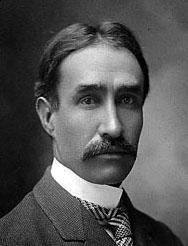Fabian Garcia
Pioneer Hispanic Horticulturist
By Dr. Paul Bosland

Dr. Garcia made many significant contributions to horticulture. As a chile pepper pioneer, one on his greatest achievements was the development of a new pod type in chile peppers, the “New Mexican” (sometimes mistakenly called the “Anaheim”). Around 1888, Fabian Garcia began a series of groundbreaking experiments to develop more standardized chile pepper varieties. Early in the 1900s, he released ‘New Mexico 9′, the first New Mexican variety with a dependable pod size and heat level. This new pod variety opened commercial markets for New Mexico chile and established the New Mexico chile pepper food industry. Thus, he is known as the Father of the Mexican Food industry of the United States. All New Mexican-type chile peppers grown today, including the “Anaheim”, owe their genetic base to Fabian Garcia’s New Mexico No. 9 cultivar. Another significant research accomplishment with chile peppers was his “raised-bed” method of growing chile peppers to reduce the disease caused by Phytophthora capsici. Garcia’s method of growing chile on raised beds to control phytophthora root rot is being rediscovered today by people unaware of his earlier research.
He was also instrumental in establishing the pecan industry in New Mexico. No native pecan trees grow in New Mexico. In the early 1900’s, he planted some of the first pecan trees in the Mesilla Valley and his four-acre planting was the largest pecan planting in New Mexico at the time. Today, New Mexico has more than 30,000 acres of pecans and thriving pecan industry.
In addition to chile peppers and pecans, Dr. Garcia laid the groundwork for New Mexico’s success in the commercial production of onions. He obtained a high yielding variety from Spain from which he selected a strain for New Mexico and named Grano (Babosa). This cultivar was sent to the Texas Agricultural Experiment Station (Crystal City, Texas) and was very successful in helping the Texas sweet onion industry. Today, the onion industry in New Mexico is worth $50 million annually.
Dr. Garcia is also credited with developing modern irrigated agriculture in New Mexico by experimenting with, and refining, the horticultural crops that could be grown in New Mexico. The father of the Mexican food industry was also the father of irrigated agriculture in New Mexico. His horticulture publications included pear, peach, grape, and plum variety tests, as well as variety trials of onion, spinach, melon, and cauliflower. He examined apple culture under irrigation, the effect of spring frosts on the peach crop, hardiness of fruit-buds and flowers to frost, growing onion seed, grape crown-gall investigations, early Grano onion culture, and codling moth investigations.
Garcia used both Spanish and English, as appropriate. Spanish was his native language, and he learned to write formal Spanish while a student at New Mexico State University. Some of Garcia’s manuscripts, Agricultural Experiment Station Bulletins, press bulletins, and speeches were written and published in both English and Spanish, making him the first American horticulturist to provide bilingual horticulture literature.
In his later years, “Old Director, ” as he came to be called, helped poor Mexican-American students by providing them rooms at the horticulture farm while they attended school. On August 6, 1948, he died at McBride’s Hospital, Las Cruces, NM. Garcia left his entire estate to New Mexico State University, in part providing a dormitory and scholarships for Mexican-American youth. “I want to help poor boys,” he said, “for I know of their hardships.”
Garcia’s legacy of excellence in both his professional and personal life inspired many in his time and continues to serve as an example at New Mexico State University. To honor Fabian Garcia’s contributions at New Mexico State University, the 45-acre horticulture farm was named after him, along with the Faculty Senate Meeting Hall, the building housing the Center for International Programs, and appropriately a dormitory, Garcia Hall, New Mexico State University’s largest residence hall. Other recognitions include the Fabian Garcia Memorial Scholarship and the Fabian Garcia Multicultural Scholars Program.